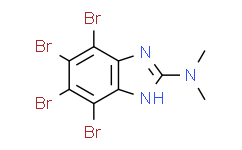| 中文名称: | DMAT | ||||
|---|---|---|---|---|---|
| 英文名称: | DMAT | ||||
| 别名: | 2-二甲基氨基-4,5,6,7-四溴苯并咪唑 CK2 Inhibitor; Casein kinase II Inhibitor | ||||
| CAS No: | 749234-11-5 | 分子式: | C9H7Br4N3 | 分子量: | 476.79 |
| CAS No: | 749234-11-5 | ||||
| 分子式: | C9H7Br4N3 | ||||
| 分子量: | 476.79 | ||||
基本信息
|
产品编号:D10800 |
|||||
|
产品名称:DMAT |
|||||
|
CAS: |
749234-11-5 |
储存条件 |
粉末 |
-20℃ |
四年 |
|
|
|
||||
|
分子式: |
溶于液体 |
-80℃ |
六个月 |
||
|
分子量 |
476.79 |
-20℃ |
一个月 |
||
|
化学名: |
|||||
|
Solubility (25°C) |
体外 |
DMSO |
50mg/mL (104.87mM; Need ultrasonic) |
||
|
Ethanol |
|
||||
|
Water |
|
||||
|
体内 |
现配现用 |
|
|||
|
<1mg/ml表示微溶或不溶。 |
|||||
|
普西唐提供的所有化合物浓度为内部测试所得,实际溶液度可能与公布值有所偏差,属于正常的批间细微差异现象。 |
|||||
|
请根据产品在不同溶剂中的溶解度选择合适的溶剂配制储备液;⼀旦配成溶液,请分装保存,避免反复冻融造成的产品失效。 |
|||||
制备储备液
|
浓度
溶液体积 质量 |
1mg |
5mg |
10mg |
|
1mM |
2.0974mL |
10.4868mL |
20.9736mL |
|
5mM |
0.4195mL |
2.0974mL |
4.1947mL |
|
10mM |
0.2097mL |
1.0487mL |
2.0974mL |
生物活性
|
产品描述 |
一种有效的,特异性的 CK2 抑制剂,IC50 值为 130nM。 |
|||
|
靶点/IC50 |
CK2 0.13μM (IC50, Human CK2) |
PIM1 0.148μM (IC50) |
PIM2 1.6μM (IC50) |
PIM3 0.097μM (IC50) |
|
HIPK2 0.37μM (IC50) |
HIPK3 0.59μM (IC50) |
DYRK1a 0.41μM (IC50) |
DYRK2 0.35μM (IC50) |
|
|
DYRK3 1.7μM (IC50) |
PKD1 0.18μM (IC50) |
CDK2 0.64μM (IC50) |
|
|
|
体外研究 |
DMAT (1 μM-2.5μM) DMAT is more efficient in killing antiestrogen resistant cells than parental antiestrogen sensitive MCF-7 cells. DMAT-induced cell death of antiestrogen resistant cells is mediated by caspases. DMAT inhibits CK2 activity but the inhibition is similar in the three cell lines, MCF-7, TAMR-1 and 182R-6. DMAT has effects on H295R cell proliferation at concentrations of 10-4 and 10-5mol/Las compared with the control. DMAT (100μM) significantly increases apoptosis of H295R cells. DMAT (1 nM-1μM) significantly decreases aldosterone release into supernatants of 72-h H295R cell cultures as compared with the control. DMAT also inhibits PIM1 by a mechanism which is competitive with respect to ATP, and it is a powerful inhibitor of kinases other than CK2 |
|||
|
体内研究 |
DMAT application in vivo reduces tumor growth in a xenotransplant model by interference with tumor cell proliferation. Biochemical parameters and histology following DMAT administration revealed no alterations in liver tissue. |
|||
推荐实验方法(仅供参考)
|
激酶实验: |
|
|
Kinase Assay |
Kinase activity tests are performed in a volume of 50μL containing (final concentrations): 0.1μg/μL protein extract, 500μM CK2 substrate peptide (RRRDDDSDDD), 25mM Tris-HCl, pH 8.5, 100μM Na3VO4, 1mM DTT, 20mM NaCl, 5mM MgCl2, 50μM ATP and appr 1μCi [γ-32P]-ATP (3000 Ci/mmol). Samples are incubated for 10 min at 30°C. Aliquots are spotted onto P81 phosphocellulose paper and washed 3×5 min in 0.75% phosphoric acid and once in acetone. Incorporation of radiolabelled phosphate is measured by counting the samples in a liquid scintillation counter. Three independent experiments, each done in duplicate, are performed with reproducible results. |
|
细胞实验: |
|
|
Cell Assay |
H295R cells are plated at a density of 2×104 cells/well into 96-well microplates in complete culture medium and preincubated for 12 h (5% CO2, 37°C, 95% humidity). DMAT in 96% ethanol and Nu-Serum-free culture medium is added to the appropriate wells at final concentrations of 10-4-10-10 M (the highest concentration of ethanol is 1.8% [vol] in the 10-4 M wells). The same volume of Nu-Serum-free culture medium and 96% ethanol is added to the control wells at the same concentration as the solvent in the 10-4 M group. Incubation is performed for 72 h under standard conditions (5% CO2, 37°C,95% humidity). The absorbance (OD, optical density) of each sample is measured with an enzyme-linked immunosorbent assay (ELISA) microplate reader at a wavelength of 450nm |
本计算器可帮助您计算出特定溶液中溶质的质量、溶液浓度和体积之间的关系,公式为:
质量 (g) = 浓度 (mol/L) x 体积 (L) x 分子量 (g/mol)
摩尔浓度计算公式
用本工具协助配置特定浓度的溶液,使用的计算公式为:
开始浓度 x 开始体积 = 最终浓度 x 最终体积
稀释公式
稀释公式一般简略地表示为:C1V1 = C2V2 ( 输入 输出 )








